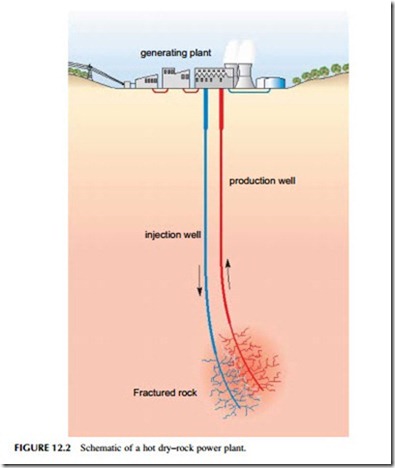BRINE-METHANE RESERVOIRS
In some rare cases the hot brine in an underwater reservoir is found to be saturated with methane too. Such reservoirs normally occur in regions rich in fossil fuel. Where such a reservoir is found it is possible in principle to exploit both the heat in the brine and the dissolved methane gas to generate electricity. The only major reservoirs of this type known today are in the Gulf of Mexico.
HOT DRY ROCK
Underground geothermal reservoirs are relatively rare. More normally hot underground rock is not permeated by water and so there is no medium naturally available to bring the heat energy to the surface.
Where hot rock exists close to the surface, it is possible to create a human-made hydrothermal source, as shown in Figure 12.2. This is accomplished by drilling into the rock and then pumping water down through the borehole that has been created. If water is pumped under sufficiently high pressure it will cause the rock to fracture—the process is similar in concept to fracking to release shale gas—creating faults and cracks through which the liquid can flow. (In fact, underground rock often contains natural faults and fractures through which the water will percolate. This often helps with the fracturing.) If a second borehole is drilled adjacent to the first, then water that has become heated as it has percolated through the rock can be extracted and used to generate electricity.
The first attempt at this hot dry–rock technique was carried out by scientists from the Los Alamos laboratory in New Mexico in 1973. Since then experiments have been carried out in Japan, the United Kingdom, Germany, and France. One such project, part of the European Hot Dry Rock Research Project, is at Soulez-sous-Forets in France. Here boreholes have been drilled to 5 km below the surface and temperatures of 201 oC found. The project is now producing a small amount (around 1.5 MW of generating capacity) of electric power.
Based on pilot schemes such as this, estimates suggest that a commercial hot dry–rock system will need to provide 10–100 MW of generating capacity over at least 20 years to be economical. The technology is still in an early stage of development and it is likely to be 10–15 years before commercial exploitation is possible.
